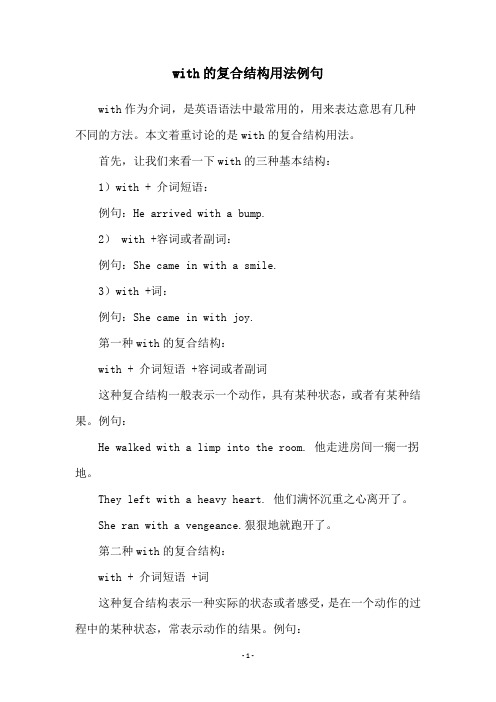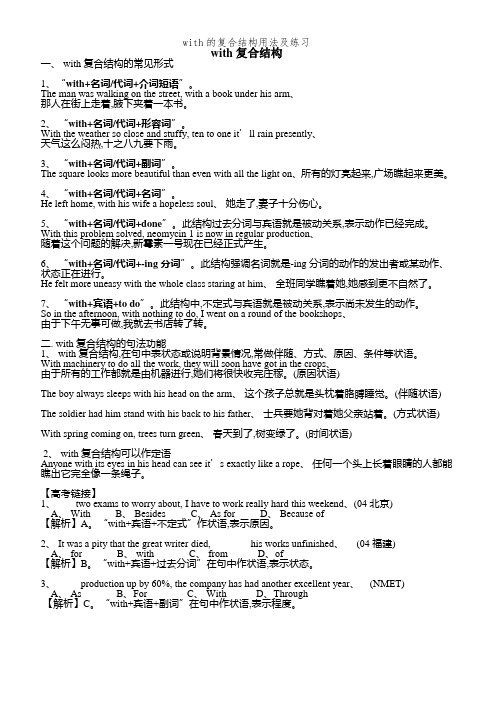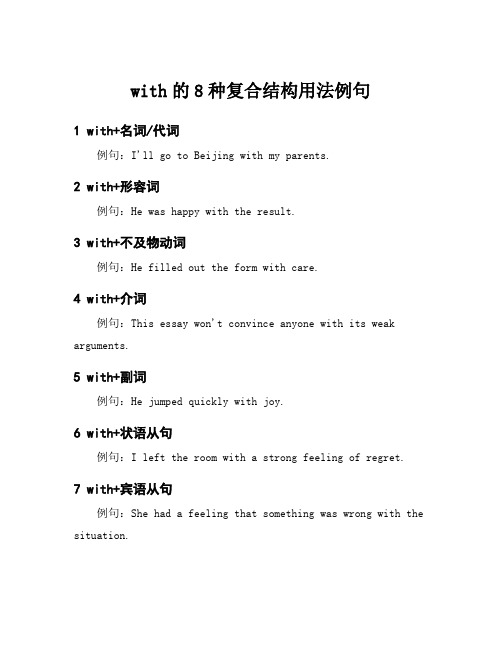with的复合结构的用法
with的复合结构用法简明总结

with的复合结构用法简明总结With的复合结构用法简明总结With是一个常见的介词,用于表示伴随或同行的关系。
它也可以与其他词组合成复合结构,以表达更多的意义和用法。
以下是一些常见的with的复合结构用法:1. With + 名词:表示伴随状态或特征With + 名词:表示伴随状态或特征- He walked down the street with a smile on his face.(他带着微笑走在街上。
)- She entered the room with confidence.(她带着自信走进房间。
)2. With + 过去分词:表示伴随的行为或状况With + 过去分词:表示伴随的行为或状况- She sat on the bench with her legs crossed.(她双腿交叉坐在长椅上。
)- The bookshelf was filled with books.(书架上摆满了书。
)3. With + 动名词:表示伴随的行为或方式With + 动名词:表示伴随的行为或方式- He opened the door with a loud bang.(他用巨大的声音打开了门。
)- She walked into the room with a graceful glide.(她优雅地滑入房间。
)4. With + 代词/名词 + 不定式:表示带有某种感情或态度的伴随With + 代词/名词 + 不定式:表示带有某种感情或态度的伴随- She listened to her friend's story with great interest.(她满怀兴趣地听朋友的故事。
)- He accepted the challenge with a determination to succeed.(他带着成功的决心接受了挑战。
)5. With + 比较级 + 不定式:表示伴随着某种程度的变化With + 比较级 + 不定式:表示伴随着某种程度的变化- The car went faster and faster, with the wind blowing through her hair.(车子越来越快,风吹拂着她的头发。
高中with的复合结构用法

高中with的复合结构用法介词with在英语中非常常见,它可以表示具有、和、用、以、跟、同、带有、使用等多种含义。
除了作为介词后面跟名词或代词作宾语外,with还可以构成复合结构,即with+宾语+宾语补足语。
这种复合结构在句中可以作状语或定语,表示伴随、原因、条件、方式等意义。
宾语补足语可以是形容词、副词、名词、介词短语、现在分词、过去分词或不定式等。
下面我们来具体看看with的复合结构的用法和例句。
1.with+宾语+形容词这种结构表示宾语的特征或状态,常用来作状语或定语。
例句:•He likes to sleep with the window open. 他喜欢开着窗户睡觉。
•She entered the room with her face red with cold. 她脸上冻得通红地走进房间。
•The boy was sitting on the ground with his eyes closed. 男孩闭着眼睛坐在地上。
•With water plentiful, the lawns were green all summer. 因为水很充足,整个夏天草坪都很绿。
•The girl was wearing a dress with flowers printed on it. 女孩穿着一件印有花朵图案的裙子。
2.with+宾语+副词这种结构表示宾语所处的位置或状态,常用来作状语。
例句:•With John away, we’ve got more rooms. 随着约翰离开,我们有了更多房间。
•He stood there with his back to me. 他背对着我站在那里。
•She walked out of the room with a smile on her face. 她面带微笑地走出房间。
•He left the house with nothing said. 他什么也没说就离开了房子。
with的复合结构用法例句

with的复合结构用法例句with作为介词,是英语语法中最常用的,用来表达意思有几种不同的方法。
本文着重讨论的是with的复合结构用法。
首先,让我们来看一下with的三种基本结构:1)with + 介词短语:例句:He arrived with a bump.2) with +容词或者副词:例句:She came in with a smile.3)with +词:例句:She came in with joy.第一种with的复合结构:with + 介词短语 +容词或者副词这种复合结构一般表示一个动作,具有某种状态,或者有某种结果。
例句:He walked with a limp into the room. 他走进房间一瘸一拐地。
They left with a heavy heart. 他们满怀沉重之心离开了。
She ran with a vengeance.狠狠地就跑开了。
第二种with的复合结构:with + 介词短语 +词这种复合结构表示一种实际的状态或者感受,是在一个动作的过程中的某种状态,常表示动作的结果。
例句:She hugged him with love.用爱拥抱了他。
The movie ended with sadness.影以悲伤结束。
He took his leave with regret. 他带着懊悔离去。
第三种with的复合结构:with +词 + 介词短语这种复合结构表示一种特定的情况或状况。
例句:His house was filled with decorations. 他的房子里满是装饰品。
The room was filled with smoke.间里充满烟雾。
The sky is filled with stars.空里满是星星。
以上是with的三种复合结构用法,它们都有丰富多彩的表达方式,在英语中经常用来表达某种额外的信息,有时候这些信息对我们的理解很重要。
with的复合结构用法及练习

with的复合结构用法及练习with复合结构一、 with复合结构的常见形式1、“with+名词/代词+介词短语”。
The man was walking on the street, with a book under his arm、那人在街上走着,腋下夹着一本书。
2、“with+名词/代词+形容词”。
With the weather so close and stuffy, ten to one it’ll rain presently、天气这么闷热,十之八九要下雨。
3、“with+名词/代词+副词”。
The square looks more beautiful than even with all the light on、所有的灯亮起来,广场瞧起来更美。
4、“with+名词/代词+名词”。
He left home, with his wife a hopeless soul、她走了,妻子十分伤心。
5、“with+名词/代词+done”。
此结构过去分词与宾语就是被动关系,表示动作已经完成。
With this problem solved, neomycin 1 is now in regular production、随着这个问题的解决,新霉素一号现在已经正式产生。
6、“with+名词/代词+-ing分词”。
此结构强调名词就是-ing分词的动作的发出者或某动作、状态正在进行。
He felt more uneasy with the whole class staring at him、全班同学瞧着她,她感到更不自然了。
7、“with+宾语+to do”。
此结构中,不定式与宾语就是被动关系,表示尚未发生的动作。
So in the afternoon, with nothing to do, I went on a round of the bookshops、由于下午无事可做,我就去书店转了转。
with复合结构的用法

with复合结构通常用作伴随、方式、原因、条件等状语。
with 复合结构是英语中一种非常常见的语法结构,它由“with + 宾语+ 宾语补足语”构成,可以用作状语、定语或独立主格形式。
这种结构可以用来说明附带情况或具体细节,表达伴随、条件、方式、原因、时间等多种含义。
以下是with复合结构的几种常见用法:表示伴随关系:例如,She came in with her husband.(她和她的丈夫一起进来了。
)表示方式或手段:例如,He opened the door with a key.(他用钥匙打开了门。
)
表示原因或理由:例如,He was absent from school with a cold.(他因为感冒缺席了学校。
)
表示条件:例如,With good weather, we can have a picnic.(如果天气好,我们可以去野餐。
)
表示时间:例如,With the sun setting, we headed back home.(随着太阳下山,我们开始回家。
)
总的来说,掌握with复合结构的用法对于提高英语写作和口语表达能力非常有帮助,尤其是在描述复杂情境时,能够使句子更加丰富和精确。
在学习过程中,可以通过大量阅读和练习来加深对这一结构的理解和应用。
with的8种复合结构用法例句

with的8种复合结构用法例句1 with+名词/代词例句:I'll go to Beijing with my parents.2 with+形容词例句:He was happy with the result.3 with+不及物动词例句:He filled out the form with care.4 with+介词例句:This essay won't convince anyone with its weak arguments.5 with+副词例句:He jumped quickly with joy.6 with+状语从句例句:I left the room with a strong feeling of regret.7 with+宾语从句例句:She had a feeling that something was wrong with the situation.8 with+状语动词例句:She played with enthusiasm.with复合结构十分常见,它和其他的复合结构有着很多共同特点,同时又有着其独特性。
with复合结构通常用来说明各部分之间的关系,可以用来提供状态、情感或变化等信息。
with复合结构可以用来表达任何我们心目中想象的东西。
with作为复合结构时,有以下8种结构用法:1 与名词或代词形成的复合结构,例如:I'll go toBeijing with my parents(我将与父母一起去北京);2 与形容词形成的复合结构,例如:He was happy with the result(他对结果很满意);3 与不及物动词形成的复合结构,例如:He filled out the form with care(他仔细填写了该表格);4 与介词形成的复合结构,例如:This essay won't convince anyone with its weak arguments(这篇文章因其弱小的论点而无法说服任何人);5 与副词形成的复合结构,例如:He jumped quickly with joy(他高兴地跳跃);6 与状语从句形成的复合结构,例如:I left the room with a strong feeling of regret(我强烈地后悔离开了房间);7 与宾语从句形成的复合结构,例如:She had a feeling that something was wrong with the situation(她有一种感觉,觉得情况不太对劲);8 与状语动词形成的复合结构,例如:She played with enthusiasm(她热情洋溢地玩耍)。
with复合结构的用法

With复合结构的用法with复合结构即“with + 宾语 + 宾语补足语或with + 复合宾语”。
宾语补足语(简称:宾补)可以是动词不定式、现在分词、过去分词、形容词、副词或介词短语等。
With 复合结构在句中常充当状语,有时也充当定语或补足语。
一、with复合结构的类型with复合结构常有以下六种形式:1、with + 宾语 + 不定式(短语)【不定式表将来,主动表被动】With a lot of difficult problems so settle, the newly-elect president is having a hard time.With you to help us, we’ll surely succeed.I cannot go out with all these dishes to wash.With all the work to do, I don’t know if I’ll have time to go out.With five minutes to go before the last train, we arrived at the station.2、with + 宾语 + 现在分词(短语)【正在发生】I felt quite happy with the birds singing in the woods.With the old man leading, the soldiers started towards the mountain.Thousands of terrified watchers stared with their hearts beating fast.With all the family traveling in America, the house seems very empty.In some parts of Asia, it’s not polite to sit with your foot pointing at another person.With so many people communicating in English every day, it will become more and more important to have a good knowledge of English.3、with + 宾语 + 过去分词(短语)【过去分词与它前面的名词或代词有被动关系】All the afternoon he worked with the door locked.The murderer was brought in, with his hands tied behind his back.He wept in his room with his heart broken.He enjoys listening to music with his eyes closed.With the job finished, we went to the seaside for a holiday.You must give me a true account, with nothing added and nothing removed.4、with + 宾语 + 形容词【形容词表状态、特征】He stared at me with his mouth open.She sat in the corner, with her face dull.He cannot go on a holiday with his mother ill.He often sleeps with the windows open even in winter.In summer we often sleep with the windows open.With everything ready, we started to work.5、with + 宾语 + 副词Our city looks more beautiful with all the lights on.He went out with no hat on.He put on his socks, (with me) wrong side out.With Mary away, John felt miserable.6、with + 宾语 + 介词短语He stood with his hand in his pocket.He was asleep with his head on his arms.The teacher stood here with a book in her hand.The teacher walked into the classroom with a ruler under his arm.The guard rushed out with a gun in his hand.二、with复合结构的用法with复合结构主要用来说明附带情况或具体细节,在句中主要用作状语,有时也用作定语、宾语补足语或主语补足语。
with 的复合结构的用法

with 的复合结构的用法
"with"是一个复合介词,用于与某人或某物一起做某事的情况。
它可以用于表示伴随特定的对象或状态进行某个动作。
以下是一些常见的用法:
1. "with" + 名词:用于描述某人或某物与另一个人或物体在一起的情况。
- 我喜欢和朋友一起看电影。
- 她站在窗前,手里拿着一杯咖啡。
- 这幅画上有一只猫。
2. "with" + 动名词:表示某人或某物在进行或完成某个动作时使用的对象。
- 她靠着墙坐在地上。
- 他打开锁,用钥匙打开了门。
- 这个厨师用刀切片。
3. "with" + 形容词:用于描述某人或某物所具有的特征或状态。
- 她戴着一顶红色的帽子。
- 孩子们兴奋地跳着。
- 这个房间里有一张大桌子。
4. "with" + 名词短语:表示某人或某物所从事的活动。
- 她和朋友们一起去度假了。
- 我在书店里看到一位作家和他的粉丝合影。
- 他的房间里放着一架吉他。
需要注意的是,“with”的后面通常是名词、形容词、动名词或名词短语等,而不是动词原形或句子。
- 1、下载文档前请自行甄别文档内容的完整性,平台不提供额外的编辑、内容补充、找答案等附加服务。
- 2、"仅部分预览"的文档,不可在线预览部分如存在完整性等问题,可反馈申请退款(可完整预览的文档不适用该条件!)。
- 3、如文档侵犯您的权益,请联系客服反馈,我们会尽快为您处理(人工客服工作时间:9:00-18:30)。
with复合结构
一、with复合结构: “with+宾语+宾语补足语” 此结构在句中常作状语,可位于句首或句尾, 常作时间、原因、方式、伴随状语,亦可作后置 定语。 二、 with复合结构的构成 1. with+宾语+adj.(adj.表状态) He used to sleep with all the windows open. 他过去常常开着窗子睡觉。 She lay in bed with her face pale. 她躺在床上,脸色苍白。
2. with+宾语+adv. (adv.表状态) Her mother sat on the chair with her head down. 她母亲坐在椅子上,头低着。 3. with+宾语+ to do (to do表将来,有时用主动形 式表示被动意义) I can’t go out with these clothes to wash. 因为这些衣服要洗,我不能出去。 I had to go to bed with nothing to do. 我没有事可做,只好睡觉。
√
√Байду номын сангаас
Exercise:
leading 1.With the boy __________the way,we found he house easily. (lead) (小男孩已领过路) to lead 2.With the boy _____________the way,we will find the house easily tomorrow. (小男孩明天将领路) 3.He lay on the bed with the bedroom door_______________. (shut ) shut
6. with+宾语+ done (done表完成或被动) With everything done, she went home. 做完一切事情以后,她回家了。
√
1. With the boy________us the way, we got there easily. A. showed B. showing C. to show D. show 2. With everything________, she went home. A. done B. being done C. to do D. doing 3. With Mr. Frank________us, I'm sure we will succeed. A. help B. helped C. to help D. helps
4. with+宾语+ 介词短语 The teacher came in with a book in his hand. 老师进来了,手里拿着本书。 5. with+宾语+doing (doing表主动或正在进行) With the machine helping us, we could finish the work on time. 由于有机器的帮助,我们能按时完成任务。
